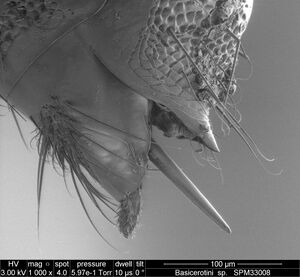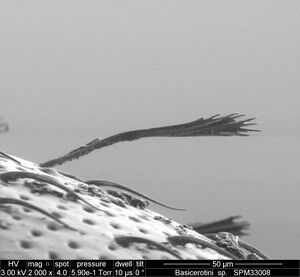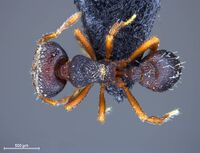Protalaridris leponcei
| Protalaridris leponcei | |
|---|---|

| |
| Scientific classification | |
| Kingdom: | Animalia |
| Phylum: | Arthropoda |
| Class: | Insecta |
| Order: | Hymenoptera |
| Family: | Formicidae |
| Subfamily: | Myrmicinae |
| Tribe: | Attini |
| Genus: | Protalaridris |
| Species: | P. leponcei |
| Binomial name | |
| Protalaridris leponcei Delsinne & Lattke, 2018 | |
This species was found at 1970 m in the leaf litter of an evergreen lower montane forest in nearly pristine condition (Homeier et al., 2008). At the type locality, P. leponcei seems to be frequently encountered although at low density. Interestingly, a worker of Protalaridris loxanensis was found together with this species in a Winkler sample at this site, being only the second case of sympatry recorded for the genus. It is possible that P. leponcei is very restricted in distribution as intense sampling carried out in the same continuous forest but 1.1 km away and at an elevation of 2070 m did not result in the collection of additional specimens. As this second site was closer to the mountain ridge, it is possible that some undetermined variables (e.g. soil properties, sun exposition, vegetation height) were perhaps sufficiently different to prohibit the occurrence of P. leponcei in that part of the forest.
Identification
Lattke et al. (2018) - Worker: Mandible highly distinctive: short, stout, triangular, and strongly bowed. Basal mandibular tooth continuous with basal rim, not separated by diastema. Frontal lobe covering most of antennal fossa in dorsal view. Frontal carina and frontovertexal ridge delimiting anterodorsally truncated area in head capsule. Eye well separated from head dorsum by twice diameter length. Labrum with anteromedian cleft extending over half its length, and with numerous translucent hairs along its margin (up to 32 hairs in holotype). Head truncated area and dorsum of promesonotum rugo-reticulate.
The species can be very easily separated from any other known Protalaridris species by the unique shape of its mandibles. In addition, the eye is relatively more developed (up to 11–12 ommatidia rather than 1–5 ommatidia in other species), and it is placed lower on the lateral cephalic region, at a further distance from the cephalic dorsum. The frontal lobe is more expanded laterally and covers most of antennal fossa in dorsal view. The connection of the frontal carina with the frontovertexal ridge, defining a truncated area on the cephalic dorsum, is also unique. The carina separating the promesonotum from the propodeum is more marked and elevated. In some aspects, Protalaridris leponcei is more reminiscent of the Octostruma ascrobicula species-group than of its congeneric species. In particular, these ants share similar mandibular shape (strongly bowed) and a basal tooth confluent with the mandibular rim. However, careful observation of tooth size show differences (for instance, tooth 3 is much larger than teeth 2 and 4 in Protalaridris leponcei, but much smaller in Octostruma ascrobicula species-group). Other similarities are the truncated area delimited by the frontal carinae and the conspicuous facial arc (although these carinae are not confluent in some Octostruma species, such as Octostruma convallisur), presence of at least two erect spatulate hairs on cephalic dorsum (except in Octostruma limbifrons), and eye distant from the cephalic dorsum by at least twice its diameter. However, Protalaridris leponcei differs by its 9-segmented antenna (8-segmented in Octostruma), its labrum divided in two lobes by an acute anteromedian cleft (labrum subrectangular without deep anteromedian incision in Octostruma ascrobicula species-group), and by the presence of suberect hairs on the first gastral tergite (some are also present in Octostruma ascrobicula species-group but are always restricted to the posterior margin of gastral tergite I).
Keys including this Species
Distribution
Only known from the type series collected at the Reserva Biológica San Francisco, which borders the Podocarpus National Park on the eastern Andean slope of southern Ecuador.
Latitudinal Distribution Pattern
Latitudinal Range: -3.97504° to -3.97504°.
| North Temperate |
North Subtropical |
Tropical | South Subtropical |
South Temperate |
- Source: AntMaps
Distribution based on Regional Taxon Lists
Neotropical Region: Ecuador (type locality).
Distribution based on AntMaps
Distribution based on AntWeb specimens
Check data from AntWeb
Countries Occupied
| Number of countries occupied by this species based on AntWiki Regional Taxon Lists. In general, fewer countries occupied indicates a narrower range, while more countries indicates a more widespread species. |

|
Estimated Abundance
| Relative abundance based on number of AntMaps records per species (this species within the purple bar). Fewer records (to the left) indicates a less abundant/encountered species while more records (to the right) indicates more abundant/encountered species. |

|
Biology
Castes
worker
    
| |
| . | |
Nomenclature
The following information is derived from Barry Bolton's Online Catalogue of the Ants of the World.
- leponcei. Protalaridris leponcei Delsinne & Lattke, in Lattke et al., 2018: 282, figs. 6a-d (w.) ECUADOR.
Unless otherwise noted the text for the remainder of this section is reported from the publication that includes the original description.
Description
Worker
Holotype: HL 0.73; HW 0.81; ML 0.21; EL 0.06; SL 0.41; PW 0.48; WL 0.76; PH 0.36; PL 0.38; DPW 0.23; PPL 0.19; PPW 0.38 mm. CI 1.12; MI 0.26; OI 0.08; SI 0.51; LPI 0.95; DPI 0.6.
Head in frontal view slightly wider than long, widest at posterior one fourth. Posterior cephalic margin straight, without median emargination, posterolaterally convex, with inconspicuous occipital lobe. Lateral cephalic margin posterior to eye broadly convex, in continuity with occipital convexity. Lateral cephalic margins anterior to eye almost straight, converging anteriorly. Frontal lobe covering most of fossa in dorsal view except for anteriormost part. Frontal carina sharp, continuous with raised frontovertexal ridge that arches across vertex (“facial arc” sensu Longino & Boudinot, 2013). Eye reduced, but distinct and visible in frontal view, 10–12 partially fused ommatidia, facing anterolaterally, separated in lateral view from antennal fossa by one diameter or less and from dorsal face by nearly two diameters. One spatulate hair on each side of ridge, posterior to eye and lateral to frontal carina.
Cephalic dorsum delimited by frontal carinae and ridge flattened (truncated) in lateral view. Cephalic dorsum posterior to frontovertexal ridge convex, curving posteriorly to form cephalic posterior margin and broadly convex ventral margin. Antennal scrobe ventrad of eye running from anterior ventral cephalic margin to occipital corner; its anterior half shallow but distinct, delimited ventrally by faint carina and dorsally by fossa ventral margin, its posterior half very shallow, not delimited by carina or flange and progressively vanishing. Occipital carina sharp and extending ventrally across posterior fourth of cephalic capsule, roughly equidistant from postgenal bridge and ventral scrobe margin. Postgenal suture visible as darker line across the head ventral area. Hypostoma sharp and projecting a little above buccal cavity as translucent lamina. Clypeus smooth and shining. Area delimited by frontal carinae and frontovertexal ridge strongly rugo-reticulate, without clear median longitudinal carina, encrusted with dirt and debris that obscure shining cuticle. Cephalic dorsum posterad of ridge, including lateral cephalic region above eye, with longitudinal rugulae, fading to smooth and shining with sparse punctae near occipital carina. Scrobe from anterior margin to eye level shallowly but densely foveolate, then with sparse punctae. Ventral head area with shallow foveolae and with irregular mostly transverse rugae. Cephalic dorsum with short appressed hairs, pointing anteromedially. Head ventrum with both short appressed hairs and 10–12 sparse longer suberect hairs.
Mandible short, stout, and triangular. Dorsal margin in lateral view strongly bowed with basal portion in same plane as clypeus and apical portion strongly bent downward. Base of mandible at cephalic insertion expands into flange with smooth rim. Mandible with 10 teeth, tooth 1 robust and continuous with basal rim, tooth 3 at least twice as long as teeth 1, 2, 4–6, these teeth subequal in length, except tooth 5 slightly longer. Teeth 7–10 forming an apical fork perpendicular to base of dorsal face, tooth 7 long and separate, tooth 8 about 1/3 length of tooth 7 (and subequal in length to teeth 1, 2, 4, and 6), tooth 9 slightly sharper than tooth 8, joined to tooth 10 at mid-length between tooth 8 and 10 (or could be interpreted as single tooth bifid at the tip), tooth 10 longer than tooth 7 (but, as the mandible is bent, teeth 7 and 10 reach the same level in dorsal view); dorsal surface of mandible roughened, ventral surface narrow, smooth and shining; interior surface strongly concave, smooth and highly polished. Mandibular dorsum with very short appressed hairs. Masticatory mandibular margin with series of translucent, flattened, lanceolate hairs inserted among teeth 1–7. Apex of mandible, close to teeth 7–10, with longer thin hairs. Single long hair, flexuous at the tip, inserted ventrally at and perpendicularly to the base of the mandible, very close to the mandible insertion with cephalic capsule.
Labrum hardly visible in dorsal view with mandibles closed; with outer lateral margin and apex forming a continuous convexity, and with acute anteromedian cleft extending over one-half labrum’s length. Both dorsal and ventral surfaces mostly smooth and shining. Hairs inserted along labral margin directed ventrally and shaped as follows: outer lateral margin of each lobe with fringe of at least 11 translucent, flattened, subrectangular hairs, serially increasing apicad in both length and width; lobe apex with single thin hair, three times as long as preceding subrectangular hair; close to cleft, 3–4 aciculate hairs, roughly as high as the apical-most subrectangular hair; minute hairs may be present within cleft. Palpal formula unknown. Scape in dorsal view with faint longitudinal rugulae with apical two-thirds mostly straight and parallel, anterobasal lobe slightly expanded anterad. Cross-section of scape at mid-length flattened, subrectangular, with external margin roughly as wide as internal margin, dorsal and ventral margins straight. External and internal scape margins defined by narrow longitudinal lamella, one along ventral margin and another along dorsal margin. Scape with sparse short decumbent hairs, denser along its internal margin. External scape margin with series of 8–10 weakly spatulate (apically fringed at 80x) erect hairs; hair closest to apex of basal lobe longest.
Promesonotum in lateral view broadly convex. Dorsal propodeal margin concave, confluent with triangular and sharply pointed propodeal tooth. Declivitous margin of propodeum straight; short lamella present from base of propodeal tooth to propodeal spiracle. In dorsal view, pronotal cervix polished, with sparse punctae and with short medial transverse carina, posteriorly marked by narrow, shallow furrow. Promesonotum covered by transversely arching rugo-reticulation, with short appressed hairs. Promesonotal suture barely distinguishable, not interrupting sculpture. Promesonotum and propodeum separated by shallow furrow obscured by particulate matter, immediately anterad of strongly raised tranverse carina marking anterior margin of propodeum. Propodeal dorsum very short with rugulae and punctae, lacking pilosity, separated from declivitous face by transversely arched carina confluent with inner margin of propodeal teeth. Declivitous face finely areolate. Lateral pronotum, mesometapleuron, and propodeum irregularly foveolate, with oblique rugulae on posterior region of pronotum and on anepisternum; wanting pilosity. Metapleural gland opening forming vertical slit covered by cuticular flange and not visible in lateral view. Bulla visible through cuticle. Petiolar node in lateral view convex to subquadrate, anterior petiolar margin mostly straight to weakly concave, anteroventral process shaped as low angular lobe, postpetiolar dorsal margin in lateral view broadly convex, convexity increasing posterad. Postpetiole flattened, transverse in dorsal view, anterior margin concave and shorter than convex posterior margin. Dorsum of petiolar peduncle finely areolate, lateral region densely foveolate. Dorsum of petiolar node with transverse rugulae; dorsum of postpetiole with fovae and fainter rugulae; both dorsa with posteriorly directed appressed short hairs.
Dorsal margin of abdominal tergum IV broadly convex in lateral view, ventral margin markedly convex, with greatest height in anterior half of gaster. Dorsum densely punctulate, space between depressions equal to 1–2 of their diameters; smoother areas present on lateral and posterior parts of tergite; pilosity consisting of sparse appressed short hairs, and some 16–20 suberect, spatulate (apically fringed) longer hairs; pilosity not obscuring sculpturing. Abdominal tergum IV with transverse carina along anterodorsal margin, separating dorsum from anterior surface. First gastral ventrum densely punctate, with appressed pilosity pointing posterad and sparse suberect spatulate hairs. Sting not visible. Tarsal claws simple, long, slender, poorly diverging (delimiting an angle of 50–60°) and strongly bent; legs stout, not elongate; protibial apex with spatulate hair anterolaterally, plus one hair posterolaterally; rest of hairs on protibia short, appressed. Meso- and metatibial apices each with anterolateral and posterolateral spatulate hairs, anterior hairs largest. Trochanters finely areolate to punctulate. Tibiae and femora finely areolate, with faint longitudinal striae on apical dorsum for tibiae. Body mostly ferruginous, darker tint along facial arc. Appendices (mandibles, antennae, legs) lighter, brownish. Tarsi except basitarsi pale yellow.
Type Material
Type material. Holotype worker (point-mounted; Royal Belgian Institute of Natural Sciences). ECUADOR. Zamora-Chinchipe: 13 km E Loja, Reserva Biológica San Francisco, “forester plot”, –3.97504° –79.07631°, 1970 m, 23.IX.2007, M. Leponce coll., in 1 m2 of sifted litter extracted during 48 h (Winkler sample). Unique specimen code RBINS33008 from sample code RBINS33700. DNA extracted from two legs by John Longino and Michael Branstetter (University of Utah). Paratypes 4 workers in RBINS, all preserved in ethanol, same data as holotype except: 1 worker, specimen code RBINS33010 from sample code RBINS33710; 1 worker, specimen code RBINS33011 from sample code RBINS33694; 1 worker, specimen code RBINS33007 from sample code RBINS33695; 1 worker, specimen code RBINS33009 from sample code RBINS33688.
Etymology
The species epithet is a patronym to honor our colleague and friend Maurice Leponce, myrmecologist at the Royal Belgian Institute of Natural Sciences, and collector of the type series. Maurice was one of the supervisors of T. Delsinne’s PhD thesis and regularly provides help to the authors with ant digitization, analyses or specimen sharing.

